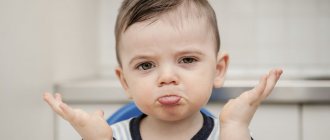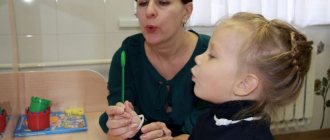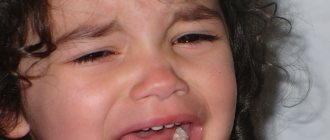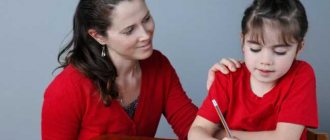Types, levels and forms of speech dysarthria in children
Table of types of disease by location of the lesion
| Name of the pathology form | Peculiarities |
| Cerebellar | Occurs when the cerebellum is involved in the process. Speech is drawn out, slurred, slow, the volume constantly changes, the child’s tongue trembles, he speaks with shouts, as if chanting slogans. Additional symptoms: poor balance, unsteady gait. |
| Bulbarnaya | It is caused by paralysis of the articulatory muscles, as well as the nerves - vagus, glossopharyngeal, ternary, sublingual and/or others. Children lack some reflexes, sucking and swallowing, facial expressions are impaired, and it is difficult for them to chew solid food. There is also increased salivation, simplification (all consonants “merge” into one fricative) and slurred sounds, a nasal, hoarse sound of the voice, sometimes its absence. |
| Pseudobulbar | Occurs with centralized paralysis (spastic) of muscles and their hypertonicity. Speech becomes monotonous, it is difficult for the child to lift the tip of the tongue, move it to the side, or hold it. There is increased salivation, soreness, and swallowing disorders (increased reflex). Speech is slurred, nasal, the pronunciation of hissing, whistling and tone sounds is sharply impaired. |
| Extrapyramidal | It occurs when the function of the subcortical nuclei is disrupted, and therefore received a second name – “subcortical”. Speech is slightly nasal, slurred, and slurred. There are involuntary muscle movements, facial expressions, and articulatory spasms. The timbre and strength of the voice changes, the pace of conversation is disrupted, and there are occasional guttural cries. |
| Cortical | Damage to those areas of the cerebral cortex that are responsible for articulatory muscles. Children pronounce words correctly in structure, but with impaired pronunciation of syllables. There is difficulty breathing during conversation and voice. |
| Cold | Manifests itself as one of the symptoms of myasthenia gravis (fatigue and weakness of striated muscles). Speech disruptions occur when the air temperature in the room where the child is located increases or decreases. |
Classification according to the degree of development of pathology:
- I (erased) - only a speech therapist can identify incorrect pronunciation during examination and examination, almost complete recovery is possible;
- II – pronunciation is clear, but defects are noticeable;
- III – the child is understood only by close people, strangers rarely;
- IV – even relatives do not understand the pronunciation or there is no speech, most often considered within the framework of cerebral palsy.
Important! The erased form is characterized by difficulty chewing solid food. Parents should not change their child's diet because of this. It is necessary to gradually accustom him to chew on the same basis as other people. Source: E.F. Arkhipova Erased dysarthria in children: a textbook for university students // M.: AST: Astrel: KHRANITEL, 2006, p.319
Diagnosis of dysarthria
Speech disorders in children and adults are dealt with by speech therapists and neurologists. The main methods for diagnosing the disease are: EEG, electromyography, neurography, MRI of the brain.
When examined by a speech therapist, a diagnosis is made based on the history of speech development, pronunciation, breathing, speech perception, articulation and many other factors that will be compared with data from neurological studies.
Treatment and prevention of dysarthria
Treatment of various types of speech disorders is always carried out comprehensively using three main areas: speech therapy, physical therapy, and drug therapy.
When making a diagnosis, the speech therapist takes into account the overall picture of the child’s speech development, and the neurologist also relies on the pregnancy history. When correcting speech, a speech therapist uses game methods; the program is developed individually for each child. Physical therapy for articulation muscles and speech therapy massage play an important role in speech correction. For successful correction, it is extremely important to identify violations in the early stages.
Since dysarthria, as a rule, manifests itself against the background of diseases of the central nervous system, drug therapy is necessary, which uses: nootropic substances, drugs for blood vessels, sedatives, drugs that stimulate metabolism.
Note that severe dysarthria cannot be completely treated; in such cases, therapy is aimed at maximizing the restoration of speech functions and the socialization of the child.
Causes and symptoms
The disease is provoked by a number of harmful factors:
- viral diseases of the expectant mother;
- pathologies of the placenta at the stage of intrauterine development;
- Rhesus conflict;
- fetal hypoxia;
- very rapid or slow labor with cerebral hemorrhage in the child;
- some birth injuries;
- prematurity;
- infections of the brain and its membranes, such as meningitis;
- Cerebral palsy (up to 85% of cases of dysarthria);
- TBI;
- hydrocephalus;
- severe intoxication;
- encephalitis. Source: L.I. Belyakova, Yu.O. Filatova Diagnosis of speech disorders // Defectology, 2007
With “erased dysarthria” there is
- Minor disturbances in speech intelligibility;
- Blurred, unclear sound pronunciation;
- Whistling, hissing and/or sonorant sounds are distorted;
- Blurred speech increases with increasing speech load;
- Disadvantages of speech breathing (rapid, shallow);
- Weak voice modulation;
- Mild disturbances in the tone of the muscles of the tongue, sometimes lips;
- A slight decrease in the volume and amplitude of articulatory movements (in some cases);
- Light salivation;
- Increased pharyngeal reflex.
Symptoms and treatment
The main symptoms include the following:
- incomprehensible, slurred speech;
- spastic manifestations in the articulatory muscles (neck, lips, face, tongue are constantly tense, articulation is limited, lips are tightly closed);
- hypotonia of the articulatory apparatus (lips do not close, tongue lies motionless in the mouth, mouth is slightly open, increased salivation);
- dystonia of articulatory muscles (when a child tries to talk, his muscle tone goes from low to high);
- slurred pronunciation;
- in difficult cases, the child misses sounds, replaces them or pronounces them distorted; Source: O.Yu. Fedosova Features of sound pronunciation of children with mild dysarthria // Speech therapist in kindergarten, 2005, No. 2, pp. 36-41
- slowness of conversation;
- inability to speak (in severe forms);
- nasal voice without signs of a runny nose;
- change, omission, replacement of some sounds with others;
- fading of a phrase towards the end of its utterance, rapid breathing during a conversation due to lack of air;
- very high, almost “squeaky” voice;
- a fast or very slow flow of words, while the child cannot change the tone.
Main disorders in dysarthria
- Violations of the tone of the articulatory muscles such as spasticity, hypotension, or dystonia;
- Impaired mobility of articulatory muscles;
- Specific violations of sound pronunciation;
- Speech breathing disorders;
- Voice disorders;
- Prosody disorders;
- Lack of kinesthetic sensations in the articulatory apparatus.
- Autonomic disorders such as increased salivation (hypersalivation), redness or paleness of the skin during speech;
- Violation of the act of eating (chewing, biting, swallowing);
- The presence of involuntary accompanying movements when performing voluntary articulatory movements;
- Increased pharyngeal (gag reflex);
- Loss of coordination of movements (ataxia);
- The presence of violent movements in the articulatory muscles.
What to do? Treatment methods for the disorder
The child must undergo additional classes with a speech therapist (at home or in a special institution) on:
- development of motor skills;
- forming a conversation;
- honing diction;
- correcting the pronunciation of distorted sounds;
- expanding vocabulary;
- development of phonetic hearing;
- memorizing grammatical structure.
Against this background, drug therapy is carried out using nootropics. Medicines in this group specifically affect brain functions: stimulate mental activity, cognitive functions, increase learning abilities, and improve memory.
The package of measures also includes exercise therapy - articulation gymnastics to strengthen the facial muscles, massage, exercises with the hands and fingers.
Sources:
- E.F. Arkhipova. Erased dysarthria in children: a textbook for university students // M.: AST: Astrel: KHRANITEL, 2006, p. 319.
- L.I. Belyakova, Yu.O. Filatova. Diagnosis of speech disorders // Defectology, 2007.
- 3. O.Yu. Fedosova. Features of sound pronunciation of children with mild dysarthria // Speech therapist in kindergarten, 2005, No. 2, pp. 36-41.
The information in this article is provided for reference purposes and does not replace advice from a qualified professional. Don't self-medicate! At the first signs of illness, you should consult a doctor.
Degrees of development of dysarthria
In speech therapy, dysarthria is divided according to the severity of symptoms and the intelligibility of speech for listeners. Thus, experts distinguish 4 degrees of the disease.
1st degree – erased dysarthria. In this case, symptoms are almost not observed and in most cases only a speech therapist can identify them. In children, such disorders are detected at the age of about 5 years. Symptoms of erased dysarthria may include: swallowing or distortion of syllables and sounds, poor diction, and generally inexpressive speech.
2nd degree of dysarthria (typical) – when pronunciation defects are clearly visible, but the speech remains understandable to the listener.
3rd degree (severe) – speech is significantly impaired and can only be understood by loved ones
4th degree – severe speech impairment – complete misunderstanding by others or absolute absence.
Article:
Introduction
One of the most pressing problems of recent years is the increase in the number of children with various speech disorders.
Among them, a very common disorder is dysarthria - a violation of the phonetic aspect of speech, which is caused by organic damage to the Central Nervous System (CNS). When it occurs, the motor mechanism of speech and its motor implementation are disrupted. In the literature of the 20th century. The concept of “dysarthria” was translated as a disorder of articulate speech; speech is organized indistinctly, like “porridge in the mouth.”
Currently, dysarthria is the most common speech pathology (out of 7 children, 5 are born with damage to the central nervous system). In 1852 For the first time, the obstetrician-scientist Little described the clinic of dysarthria in cerebral palsy. In 1911 Logo therapist Gutsman identified signs of dysarthria in people who do not have cerebral palsy. Doctor Margulis introduced the classification of dysarthria for the first time; he laid down the doctrine of dysarthria. In subsequent years, the domestic scientist O.V. Pravdina described in detail dysarthria with pseudobulbar paresis. The end of the 50s was marked by the work of E.N. Vinarskaya, who examines dysarthria from the psycholinguistic side.
The depth and complexity of the problem of dysarthria lies, first of all, in the fact that there is a direct relationship between the level of speech development and the level of development of basic mental functions, as well as the level of intellectual development. In other words, a child with speech impairment may face serious difficulties in mastering literacy and writing, problems with the development of attention and thinking, imagination and perception, and memory. In this regard, there is a need for additional study of speech problems, as well as the development of ways to overcome and correct them.
In recent years, due to the prevalence of dysarthria, theoretical and practical research into this disorder has continued, and a system of speech therapy work for its correction has been developed. They are associated with the names of M.B. Eidinova, K.A. Semenova, E.M. Mastyukova, E.F. Arkhipova, G.V. Chirkina and others.
Within the framework of this work, the problem of the peculiarities of speech therapy work for dysarthria is considered.
The object of the study is dysarthria as a speech disorder.
The subject of the study is a system of speech therapy work for the correction of dysarthria.
The purpose of the study is to identify the features of the system of speech therapy work for dysarthria.
Tasks:
- Study the theoretical foundations, citing the concept and characterizing the signs of dysarthria as a speech disorder.
- Describe the main approaches to speech therapy for dysarthria.
- Characterize the features of speech therapy work for dysarthria.
The methodological basis of the study was made up of materials from educational and scientific publications on the problem of dysarthria and the work of speech therapists with this disorder, as well as information resources on speech therapy and articles from special periodicals.
To achieve the set goals and objectives, the following scientific research methods were used:
- literature search and study
- presentation and description
- analysis and synthesis
The purpose and objectives of the work determined its structure. It is presented with an introduction, two main chapters and a conclusion. A list of references is also provided.
Chapter 1. Theoretical foundations for studying the features of speech therapy work for dysarthria
- Definition of dysarthria
First of all, let's look at the definition of dysarthria. This term comes from the Greek words meaning “difficulty, disorder” and “join, connect.”
The clinical picture of dysarthria was first described in the 19th century, when, as a result of studies by such authors as A. Oppenheim, H. Gutzman, A. Kussumaul, it was isolated from the group of sound-pronunciation disorders. At the turn of the 19th and 20th centuries, factors were first described that, according to researchers, can lead to speech disorders that can be observed with dysarthria.
Subsequently, the study of dysarthria was associated, first of all, with identifying its causes and classifying manifestations depending on these causes. By the end of the last century, two main approaches had emerged in this direction.
The first of these relies on a neurological understanding of the causes of disorders. It takes into account the pathogenesis of the clinical manifestations of dysarthria, the localization of the lesion, the nature of speech disorders in the syndrome of corresponding movement disorders. The second approach is neurophonetic, which involves phonemic analysis of dysarthric speech based on modern psycholinguistics. The emphasis is on the pathogenetic analysis of identifying neurophonetic dysarthria syndromes.
Based on the indicated approaches, various definitions of dysarthria emerge. According to the first of them (authors L.S. Volkova, V.I. Seliverstov), dysarthria is considered as a disorder of the pronunciation side of speech, in which the prosodic side of the sound flow, the phonetic coloring of sounds or incorrect implementation of phonemic signal signs of the sound structure of speech (omissions, substitutions) suffers. sounds).
According to the second approach (authors K. Becker, M. Sovak), dysarthria is a violation of the coordination of the speech process, which is a symptom of damage to the motor analyzer and efferent system, and in which the ability to articulate speech and articulation in general is impaired.
Based on the above two definitions, one of which is based on the external manifestations of pathology, and the second indicates the presence of damage to the central and peripheral nervous system, the most complete general understanding of dysarthria is emerging. It considers a violation of sound pronunciation and prosodic aspects, caused by an organic insufficiency of innervation of the muscles of the speech apparatus and the presence of damage to the central and peripheral nervous system.
There are several forms of dysarthria, differing in the external features of manifestation and the location of the lesion in the cerebral cortex. The forms of dysarthria are: bulbar, cortical, cerebellar, extramypamydal, parkinsonian, pseudobulbar, extrapyramidal, cold, erased.
- Features of the manifestation of dysarthria
Dysarthria, as a complex speech disorder, has various manifestations, expressed to a greater or lesser extent in each of the cases of occurrence. Here are the main defects in children.
The general motor skills of children with dysarthria are characterized by a limited range of active movements. Under functional loads, children get tired quickly. Motor incompetence is especially pronounced in classes that require coordination of movements, maintaining tempo and rhythm, and switching from one movement to another.
Often, children with dysarthria are late and have difficulty mastering self-care skills related to fine motor skills. They also have difficulty holding a pencil, strain their hands when drawing, and are awkward when working with plasticine or doing appliqué. In works on appliqué, difficulties in the spatial arrangement of elements can also be traced. Violation of fine movements of the hand is manifested when performing sample tests of finger gymnastics. Children find it difficult or simply cannot perform an imitation movement without outside help, for example, “lock” - put their hands together, intertwining their fingers; “rings” - alternately connect the index, middle, ring and little fingers with the thumb, and other finger gymnastics exercises. In this regard, such children often refuse to play with small parts, construction sets, puzzles, etc. When entering school, children show difficulties in mastering graphic skills (some experience “mirror writing”; substitution of letters “d”-“b”, vowels, word endings; poor handwriting; slow pace of writing, etc.).
Pathological features in the articulation apparatus are revealed. Pareticity of the muscles of the organs of articulation is manifested in the following: the face is hypomimic, the facial muscles are flaccid upon palpation; Many children do not maintain the closed mouth position, because the lower jaw is not fixed in an elevated state due to laxity of the masticatory muscles; lips are flaccid, their corners are drooping; During speech, the lips remain flaccid and the necessary labialization of sounds is not produced, which worsens the prosodic aspect of speech.
The tongue with paretic symptoms is thin, located at the bottom of the mouth, flaccid, the tip of the tongue is inactive. With functional loads (articulation exercises), muscle weakness increases. Spasticity of the muscles of the organs of articulation is manifested in the following: the face is amicable, the facial muscles are hard and tense on palpation. The lips of such a child are constantly in a half-smile: the upper lip is pressed against the gums. During speech, the lips do not take part in the articulation of sounds.
Many children who have similar symptoms do not know how to perform the “tube” articulation exercise, i.e., stretch their lips forward, etc. With a spastic symptom, the tongue is often changed in shape: thick, without a pronounced tip, and inactive. Hyperkinesis with erased dysarthria manifests itself in the form of trembling, tremor of the tongue and vocal cords. During functional tests and loads, tongue tremor appears.
Apraxia with erased dysarthria is simultaneously detected in the inability to perform any voluntary movements with the hands and organs of articulation. In the articulatory apparatus, apraxia manifests itself in the inability to perform certain movements or when switching from one movement to another. Kinetic apraxia can be observed when the child cannot smoothly transition from one movement to another.
Other children experience kinesthetic apraxia, when the child makes chaotic movements, “groping” for the desired articulatory position. Deviation, i.e. deviation of the tongue from the midline, also manifests itself during articulation tests and during functional loads. Deviation of the tongue is combined with asymmetry of the lips when smiling with a smoothness of the nasolabial fold.
Hypersalivation (increased salivation) is detected only during speech. Children cannot cope with salivation, do not swallow saliva, and the pronunciation side of speech and prosody suffer. When examining the motor function of the articulatory apparatus in children with erased dysarthria, the ability to perform all articulation tests is noted, i.e. Children, according to instructions, perform all articulatory movements - for example, puff out their cheeks, click their tongue, smile, stretch out their lips, etc.
When analyzing the quality of performing these movements, one can note: blurriness, unclear articulation, weakness of muscle tension, arrhythmia, decreased range of movements, short duration of holding a certain pose, decreased range of movements, rapid muscle fatigue, etc. Thus, under functional loads, the quality of articulatory movements sharply falls. During speech, this leads to distortion of sounds, their mixing and deterioration in the overall prosodic aspect of speech.
Dysarthria is characterized by the presence of disturbances in sound pronunciation. When examining it, the following are found: confusion, distortion of sounds, replacement and absence of sounds, which are also accompanied by violations of the prosodic side. Children often distort sounds, mixing not only articulatory complex sounds that are close in place and method of formation, but also acoustically opposed ones. One of the most common disorders is a defect in the pronunciation of whistling and hissing sounds.
Children with dysarthria distort and mix sounds. Quite often, interdental pronunciation and lateral overtones occur. Children have difficulty pronouncing words with a complex syllabic structure; they simplify the sound content by omitting some sounds when consonants are combined.
The intonation-expressive coloring of the speech of children with dysarthria is sharply reduced. Violations in speech timbre, voice modulations, speech rate, and breathing are noticeable.
It should be noted that all of these disorders are individual in nature and do not necessarily occur in every child. The severity of one or another set of signs allows children with manifestations of dysarthria to be divided into groups:
- Children with disorders of sound pronunciation and prosody. The general level of speech development of such children is quite high; they speak coherent speech and have a rich vocabulary. Difficulties appear when pronouncing words with a complex syllable structure, or when learning and reproducing prepositions. In children, spatial orientation disorders are often encountered.
- Children with disorders of the sound and prosodic aspects of speech combined with underdevelopment of phonemic hearing. In children's speech there are isolated lexical and grammatical errors and disturbances in word formation. As a rule, the vocabulary is limited and lags behind the age norm.
- Children with polymorphic sound pronunciation disorders and insufficient development of the prosodic aspect of speech. In speech, errors in differentiating sounds, composing coherent statements, and grammatical structure of sentences are clearly expressed. The vocabulary is significantly behind the age norm.
To summarize all of the above, we note that dysarthria, as a complex speech disorder, which has an organic lesion of the central nervous system as the main cause, can have different forms and degrees of manifestation. They are determined, first of all, by the characteristics of the manifestation and the location of the lesion in the cerebral cortex. The main manifestations of dysarthria are: phonetic and phonemic disorders, disorders of prosody and the lexico-grammatical component of the language, disorders of general, fine and articulatory motor skills.
Depending on the combination of manifestations, children with dysarthria can be divided into groups that differ in the nature and complexity of the disorders.
- The main directions and content of speech therapy work for dysarthria
One of the most important areas of speech therapy research on dysarthria is the search for ways to correct and compensate for it. Many authors, such as M.B., have dealt with the problems of the content of speech therapy work for dysarthria. Eidinova, O.V. Pravdiva, K.A. Semenova, E.M. Mastyukova and others.
Currently, the work to eliminate dysarthria is complex and includes three blocks: medical, psychological-pedagogical and speech therapy. Let us give their characteristics.
The content of medical work to overcome dysarthria is determined by a neurologist. It is based on the diagnosis of organic causes of dysarthria, the study of all factors of its occurrence and attempts to overcome the root cause of the disorders. As a rule, as part of medical work to overcome dysarthria, the use of medications, physiotherapy and reflexology, physical therapy and massage is used.
The psychological and pedagogical block includes the work system of educators (teachers), psychologists and parents. Often, children with a similar picture of organic disorders demonstrate significant differences in the content of speech due to pedagogical reasons. Working with children with dysarthria includes the general development of their mental functions and training of sensory qualities. Thus, the development of perception - auditory and visual - serves to prepare the basis for the formation of phonemic hearing and visual memorization of future correct spelling. The work of teachers and psychologists also includes the development and correction of spatial representations, the fundamentals of design and combinatorics.
The third block includes the work of a speech therapist, which is always carried out individually and is developed directly for each child.
Speech therapy work, as a rule, includes the following stages:
- Preparatory (in which the speech apparatus is prepared for the formation of correct articulation). This stage includes work to normalize muscle tone, motor skills of the articulatory apparatus, breathing, voice, prosody and fine motor skills of the hands.
- The stage of developing new pronunciation skills (during which the development of basic articulatory structures, the development of phonemic hearing, production, automation and differentiation of problem sounds continues).
- The stage of developing communication skills (at this stage, acquired speech skills are trained and the child’s self-control is developed when pronouncing the given sounds).
- A stage that includes overcoming or preventing secondary disorders.
- The stage of preparation for studying at school (includes the formation of graphomotor skills, the development of coherent speech, the development of cognitive activity and broadening the child’s horizons).
The duration of work at each stage of speech therapy work is determined individually and involves the use of exercises suitable for the child in accordance with his type of speech disorder.
Speaking about the features of speech therapy work for dysarthria, it should be noted that it is based on the following theoretical principles:
- Modern scientific ideas about the symptoms and structure of speech defects in dysarthria, based on the recognition of the leading role in the structure of speech defects in children, violations of the phonetic aspect of speech, which have their own specific mechanism.
- Level organization of the construction of movements, which allows you to decompose a complex motor act into its component components and identify their role in the regulation of movements and actions.
- The position on the role of kinesthesia in the control of movements, the interaction of the kinesthetic and kinetic bases of movements, based on the understanding that for the implementation of a motor act it is necessary to have two components: its kinesthetic basis, which provides a differentiated composition of complex movements, and its kinetic structure, which underlies the formation smooth motor skills.
- Statement about the relationship between the state of speech and the state of the child’s motor sphere.
- Psychophysiological mechanisms of mastering sound pronunciation are normal, suggesting a relationship between the perception of sounds and their reproduction.
- Specific relationship between articulatory and acoustic characteristics of speech sounds in normal and pathological conditions.
Speech therapy is also based on a number of principles:
- Systematicity, i.e. understanding speech as a complex functional system in which all components are interconnected.
- Taking into account the mechanisms of the disorder, identifying the leading disorders and the relationship between speech and non-speech symptoms in the structure of the defect (etiopathogenetic principle).
- Reliance on the patterns of ontogenetic development, which involves taking into account the sequence of formation of mental functions that takes place in ontogenesis.
- Development (taking into account the immediate zone of development), which consists of gradually increasing the complexity of tasks and lexical material in the process of speech therapy work.
- Stage-by-stage formation of mental actions.
- Accounting for leading activities of age.
- A differentiated approach, which involves taking into account the etiology, mechanisms, symptoms of disorders, age and individual characteristics of each child and is reflected in the organization of individual, subgroup and frontal classes.
Chapter 2. Speech therapy work for dysarthria
- Study preparation
Based on the study of the theoretical foundations of organizing speech therapy work for dysarthria, we organized and conducted an experimental study, for participation in which two groups of children aged 6-7 years were formed, 20 children in each group.
The purpose of the study is to study the characteristics of speech therapy work for dysarthria.
Research objectives corresponding to the stages of work:
- Preparation of the study, sampling of participants, search for methods of speech therapy examination
- Examination of the characteristics of speech disorders in children using special techniques (ascertaining experiment)
- Carrying out speech therapy work to correct dysarthria
- Repeated examination of children in the control and experimental groups
To examine children, diagnostics were carried out in the following areas:
- Diagnostics of the formation of phonemic hearing, including:
- Recognition of non-speech sounds
- Distinguishing pitch, strength, timbre of voice
- distinguishing words that are similar in sound composition;
- syllable differentiation;
- phoneme differentiation;
- basic sound analysis skills.
- Diagnostics of the syllabic structure of words
- Examination of the grammatical structure of speech:
- Examination of the syntactic form of an utterance
- Identification of morphemic agrammatisms
- Agreement of words in gender, number and case
- Changing the number of nouns
- Changing verb tense
- Examination of the syntactic form of a statement:
- Repeating a sentence
- Making sentences based on pictures
- Verification of proposals
- Complementing sentences with prepositions
- Completing a sentence with a phrase
- Making a complex sentence based on two pictures using conjunctions
- Diagnostics of hand motor skills:
- Praxis with verbal instructions
- Praxis by visual pattern
- Praxis according to the kinesthetic pattern
- Determination of constructive praxis (method “Cut pictures”)
- Detection of synkinesis
- Study of the kinetic basis of hand movement
- Diagnosis of spatial orientation:
- Spatial Perception Research
- Movement Accuracy Study
- Graphic Skills Study
- Monometric test "Circle cutting"
- Examination of the state of articulatory and facial motor skills
- Diagnosis of muscle tone
- Ability to perform voluntary and involuntary movements
- Number of articulatory and facial movements
- Examination of kinesthetic and kinetic praxis
- Examination of dynamic coordination of articulatory movements
- Examination of facial muscles
- Examination of muscle tone and lip mobility
- Examination of the muscle tone of the tongue and the presence of pathological symptoms
- Examination of the prosodic side of speech:
- Rhythm perception examination
- Rhythm reproduction examination
- Examination of intonation reproduction
- Examination of the perception of logical stress
- Examination of voice modulation by pitch and strength
- Identification of nasal voice timbre
- Voice perception examination
- Speech breathing examination
- Examination of the tempo-rhythmic organization of speech
- Examination of the state of auditory self-control
As a result of the survey of study participants, we obtained the following data, summarized in table form:
| Diagnostic area | Control group | Experimental group | |||
| Number of children with disabilities | % of total number of children | Number of children with disabilities | % of total number of children | ||
| 12 | 60% | 11 | 55% | |
| 8 | 40% | 10 | 50% | |
| 4 | 20% | 5 | 25% | |
| 4 | 20% | 4 | 20% | |
| 6 | 30% | 8 | 40% | |
| 12 | 60% | 15 | 75% | |
| 14 | 70% | 9 | 45% | |
| 10 | 50% | 12 | 60% | |
We also present the data in a graphical representation:
From the data obtained, we see that the percentage of violations of various aspects of speech is high in both groups. At the same time, the highest percentage of violations was recorded in diagnostic areas 1, 6, 7, 8. These are disorders of phonemic hearing, spatial orientation, articulatory and facial motor skills, and the prosodic aspect of speech.
The smallest number of violations was recorded for indicators such as 3 and 4, i.e. grammatical structure of speech and syntactic design of statements.
The difference between the indicators of the control and experimental groups differs significantly only in indicator 7, i.e. articulatory and facial motor skills. Differences in indicators 2,5,6,8 were also noted.
Thus, before the start of the formative experiment, 100% of children had speech development disorders.
- Progress and content of practical work
The next stage of the experiment involved conducting speech therapy work to correct dysarthria in children from the experimental group. In the control group, individual speech therapy work was not carried out.
Speech therapy work was built in several stages:
- Preparatory, during which differentiated speech therapy massage was carried out in order to normalize the muscle tone of facial and articulatory muscles. At this stage, the speech therapist also conducts differentiated techniques of articulatory gymnastics in order to normalize the articulatory apparatus, voice and breathing exercises to normalize the voice, speech breathing and prosody. Additionally, finger gymnastics and hand massage are performed to normalize fine motor skills and prepare the hand for graphomotor skills.
- The stage of developing new pronunciation skills. The directions of the second stage of speech therapy work are carried out against the background of ongoing exercises listed in the first stage, but more complex. The directions of the second stage are: development of basic articulatory patterns (dorsal, cacuminal, alveolar, palatal), correction of sound pronunciation, clarification or development of phonemic hearing, evocation of sounds, their consolidation (automation) and differentiation.
- The third stage of speech therapy work is devoted to the development of communication skills. One of the most difficult areas of work is developing self-control skills in a child. An important direction at this stage is the introduction of sound into speech in a learning situation (memorizing poetry, composing sentences, stories, retellings, etc.). The specific direction of the stage is the inclusion of prosodic means in the lexical material: various intonations, modulations of the voice in pitch and strength, changes in the tempo of speech and timbre of the voice, determination of logical stress, observance of pauses, etc.
- The fourth stage of speech therapy work is called preventing or overcoming secondary disorders in dysarthria.
During the practical work, recommendations on the organization of speech therapy work authored by E.F. Arkhipova, V.M. Akimenko, I.V. Blyskina, L.V. Lopatina and O.P. Prikhodko were used.
- Results of practical work and their analysis
After the completion of the formative experiment, the children were re-examined in the same areas as before the start of the formative experiment. As a result, the following data was obtained:
| Diagnostic area | Control group | Experimental group | |||
| Number of children with disabilities | % of total number of children | Number of children with disabilities | % of total number of children | ||
| 11 | 55% | 4 | 20% | |
| 8 | 40% | 5 | 25% | |
| 2 | 10% | 2 | 10% | |
| 3 | 15% | 2 | 10% | |
| 4 | 20% | 2 | 10% | |
| 10 | 50% | 6 | 30% | |
| 12 | 60% | 2 | 10% | |
| 10 | 50% | 4 | 20% | |
We also present the results obtained graphically:
From the results obtained, we see that the indicators have changed in both groups. At the same time, the indicators of the control group did not change significantly, while in the experimental group the number of speech disorders manifested in children changed significantly.
Thus, we can draw a conclusion about the effectiveness of the speech therapy work performed.
Conclusion
This work examines the problem of speech therapy work with dysarthria, which is one of the most common speech disorders in children of preschool and primary school age. Based on studying the theoretical foundations of the problem and conducting a formative experiment, we came to the following conclusions.
Dysarthria is a violation of sound pronunciation and prosodic aspects, caused by organic insufficiency of innervation of the muscles of the speech apparatus and the presence of damage to the central and peripheral nervous system. There are several forms of dysarthria, differing in the external features of manifestation and the location of the lesion in the cerebral cortex.
Dysarthria has various manifestations, in addition to disturbances in sound pronunciation, in the development of gross and fine motor skills, articulation, spatial orientation, etc.
Speech therapy work for the correction of dysarthria is based on the following principles: systematicity, taking into account the mechanisms of the disorder, relying on the patterns of ontogenetic development, taking into account the immediate zone of development, the gradual formation of mental actions, taking into account the leading activities of age, a differentiated approach.
List of references and sources
- Akimenko V.M. New speech therapy technologies. – Rostov n/d.: Phoenix, 2008. – 234 p.
- Arkhipova E.F. Speech therapy massage for dysarthria. – M.:AST:Astrel, 2008. – 123 p.
- Arkhipova E.F. Features of speech therapy work for dysarthria. // Correctional pedagogy. - No. 1. – 2004. – p.36-42.
- Arkhipova E.F. Erased dysarthria in children. - M.: AST: Astrel, 2007. - 331 p.
- Arkhipova E.F. Correctional and speech therapy work to overcome erased dysarthria in children. – M.: AST: Astrel. – 2008. – 254 p.
- Belyakova L.I. Development of speech breathing in preschoolers with speech impairment: method. allowance. – M.: Knigolyub, 2005. – 55 p.
- Blyskina I.V. An integrated approach to the correction of speech pathology in children. Speech therapy massage. – St. Petersburg: Detstvo-Press, 2004. – 112 p.
- Borisova E.A. Individual speech therapy sessions with preschoolers. - M.: TC Sfera, 2008. - 64 p.
- Dyakova E.A. Speech therapy massage. – M.: Academy, 2003. – 96 p.
- Dyakova E.A. Basic principles of using speech therapy massage in correctional and pedagogical work. // Speech therapist in kindergarten. – 2005. – No. 5. - With. 102-110.
- Efimenkova, L. N. Formation of speech in preschool children. – M.: Vlados, 2001. – 112 p.
- Kopylova S.V. Correctional work with children with dysarthric speech disorders. //Education and training of children with developmental disorders. – 2006. – No. 3. – p. 63-65.
- Kostenkova O.N. An integrated approach to overcoming speech disorders in children. // Speech therapist in kindergarten. – 2008. – No. 9. – p.66-71.
- Lopatina L.V. An integrated approach to diagnosing erased dysarthria in preschool children. // Speech therapist in kindergarten. – 2005. – No. 4. – p.50-52.
- Lopatina L.V. Speech therapy work with preschool children with minimal dysarthric disorders: Textbook. - St. Petersburg: Soyuz, 2005. - 192 p.
- Povalyaeva M.A. Speech therapist's reference book. – Rostov n/d.: Phoenix, 2002. – 448 p.
- Prikhodko O.G. Dysarthric speech disorders in children of early and preschool age. // Special education. – 2010. No. 2. – p.68-81.
- Prikhodko O.G. Principles, objectives and methods of speech therapy work for dysarthria. // Special education. – 2010. – No. 4. – p.57-79.
- Prikhodko O.P. Speech therapy massage for dysarthric disorders in children of early and preschool age. – St. Petersburg: KARO, 2008.- 160 p.
- Fateeva N.M., Chubenko E.A., Posokhova M.A., Shanaurina O.A. The use of breathing techniques for the formation of speech breathing in children with pseudobulbar dysarthria. // Special education. – 2010. – No. 2. - With. 44-50.
- Chirkina G.V. The problem of teaching children with speech impairments in the context of their special educational needs. // Scientific notes. Electronic scientific journal of Kursk State University. – 2012. – No. 2. - With. 155-166.







